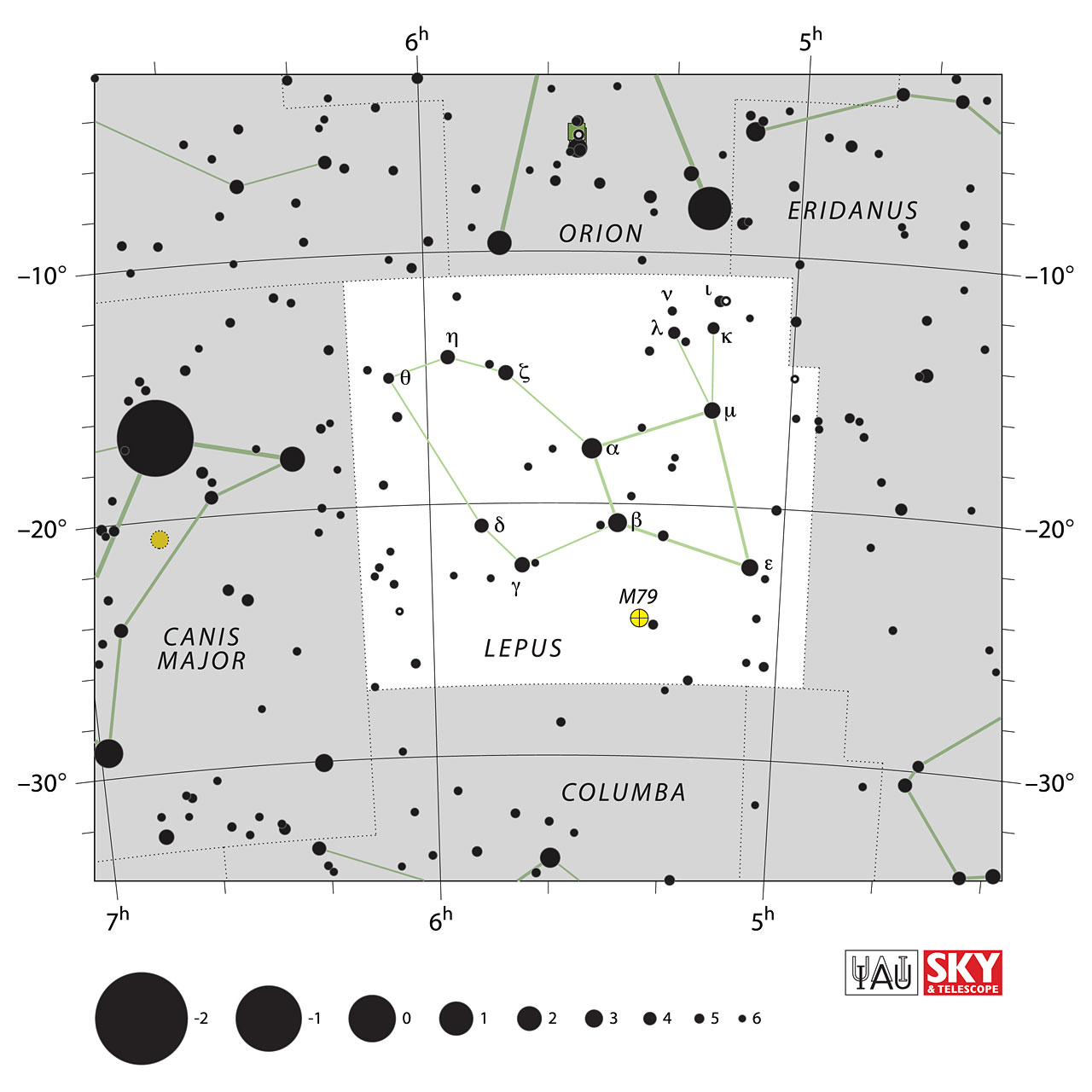Lepus


 Lepus lies immediately south of Orion, where it culminates at midnight in the December sky.
Lepus lies immediately south of Orion, where it culminates at midnight in the December sky.
The name ‘Lepus’ is Latin for hare, and the creature represented here is often said to be chased by Orion’s two dogs, Canis Major and Canis Minor. For sure, the two dogs rise and set about an hour behind Lepus. However, the hare is not usually depicted in flight, but rather couched at the hunter’s feet.
Lepus is a relatively faint constellation: its brightest star is of third magnitude and is called Arneb, Arabic for ‘hare’. Its only Messier object is the eighth-magnitude globular cluster M79.
In the Indian system, the constellation is known as ಶಶ (Shasha).
Lepus contains:
-
Stars
- Arneb (mag 2.6)
- Nihal (mag 2.8)
- ε-Lep (mag 3.2)
- μ-Lep (mag 3.3)
- ζ-Lep (mag 3.5)
- γ-Lep (mag 3.6)
- η-Lep (mag 3.7)
- δ-Lep (mag 3.8)
- λ-Lep (mag 4.3)
- κ-Lep (mag 4.4)
- ι-Lep (mag 4.4)
- θ-Lep (mag 4.7)
- HD 34968 (mag 4.7)
- HD 32309 (mag 4.9)
- SS Lep (mag 5.0)
- HD 32436 (mag 5.0)
- HD 41312 (mag 5.0)
- HD 34310 (mag 5.0)
- 8-Lep (mag 5.2)
- ν-Lep (mag 5.3)
- 19-Lep (mag 5.3)
- HD 35162 (mag 5.4)
- HD 41841 (mag 5.5)
- HD 42301 (mag 5.5)
- HD 34538 (mag 5.5)
-
Open Clusters
- None
-
Globular Clusters
- Messier 79 (mag 7.7)
-
Galaxy
- NGC 1964 (mag 10.8)
- NGC 2196 (mag 11.2)
- NGC 1832 (mag 11.4)
- NGC 1744 (mag 11.4)
- NGC 2139 (mag 11.7)
- NGC 1784 (mag 11.8)
- NGC 1888 (mag 12.0)
- NGC 2179 (mag 12.4)
- NGC 1954 (mag 12.5)
- NGC 1889 (mag 12.6)
- NGC 2076 (mag 12.7)
- IC 438 (mag 12.8)
- NGC 1979 (mag 12.8)
- NGC 2089 (mag 12.9)
- NGC 1730 (mag 13.0)
- NGC 2106 (mag 13.1)
- IC 2143 (mag 13.4)
- NGC 1993 (mag 13.4)
- IC 2152 (mag 13.4)
- NGC 2124 (mag 13.4)
- NGC 2073 (mag 13.4)
- IC 2104 (mag 13.6)
- NGC 1886 (mag 13.6)
- NGC 1738 (mag 13.7)
- IC 2121 (mag 13.8)
View Lepus in 3D 
Source: Wikipedia, in-the-sky.org
Image Courtesy: Sky&Telescope & IAU, Illustration Images linked from Urania's Mirror on Wikmedia Commons by Sidney Hall
Image Courtesy: Sky&Telescope & IAU, Illustration Images linked from Urania's Mirror on Wikmedia Commons by Sidney Hall
